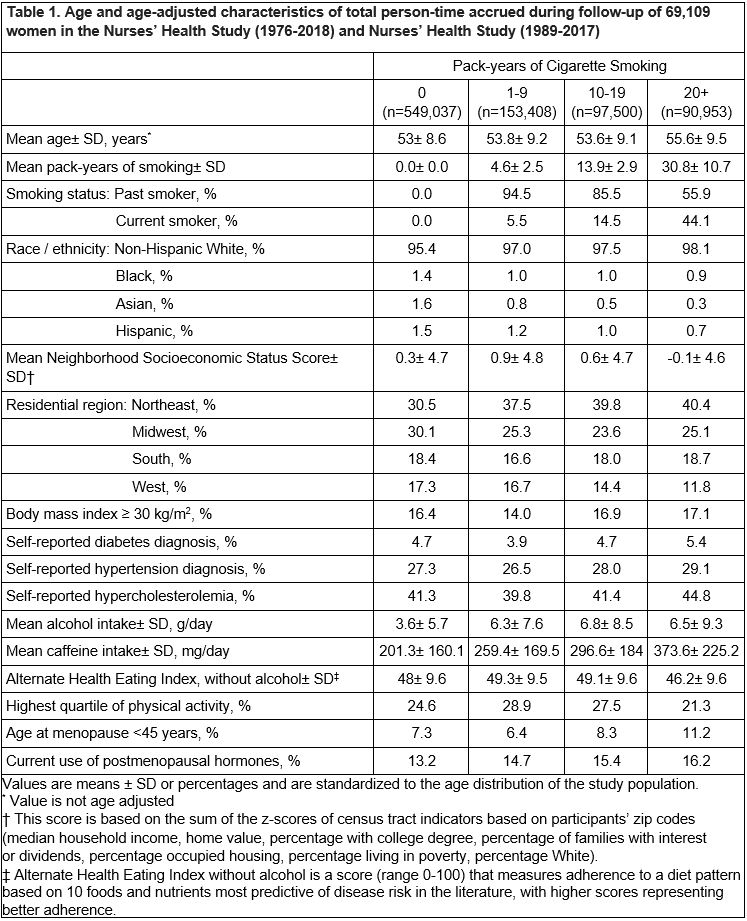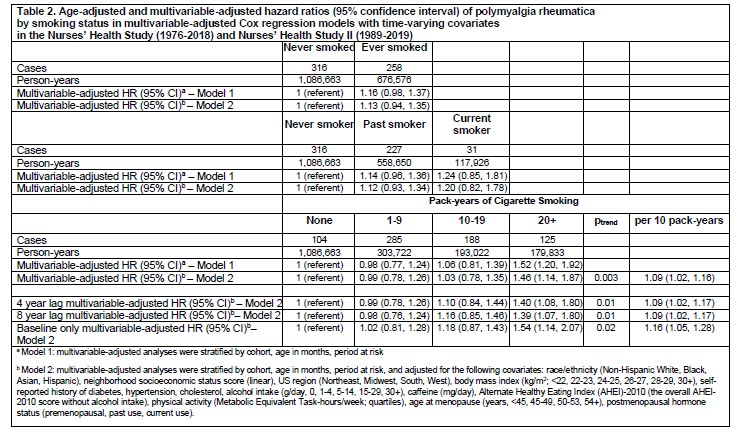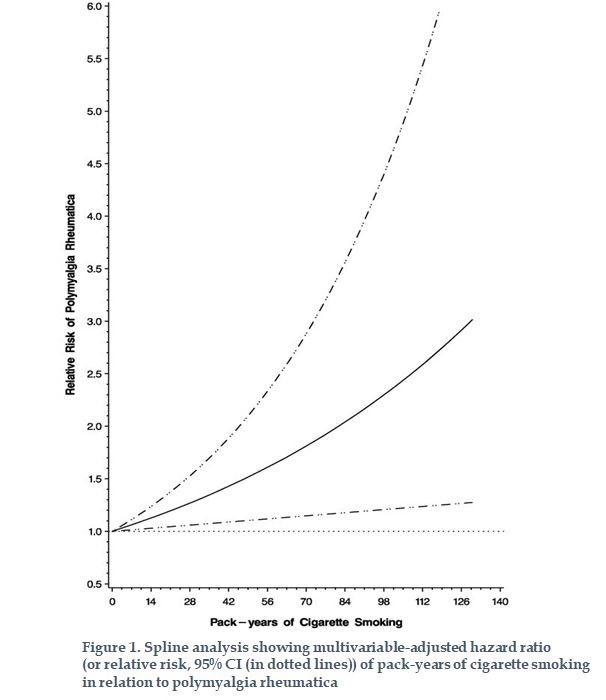Back
Poster Session B
Epidemiology, health policy and outcomes
Session: (0695–0723) Epidemiology and Public Health Poster I
0698: Cohort Study of Cigarette Smoking and the Risk of Developing Polymyalgia Rheumatica Among Women
Sunday, November 13, 2022
9:00 AM – 10:30 AM Eastern Time
Location: Virtual Poster Hall

Karen Costenbader, MD, MPH
Brigham and Women's Hospital/ Harvard Medical School
BOSTON, MA, United States
Abstract Poster Presenter(s)
Jae Hee Kang1, Susan Malspeis2, Nicole Yang2 and Karen Costenbader2, 1Brigham and Women's Hospital, Harvard Medical School, Boston, MA, 2Brigham and Women's Hospital, Boston, MA
Background/Purpose: Polymyalgia rheumatica (PMR) is the most common inflammatory rheumatic disease among older White women, but little is known of its etiology and there are few established risk factors. Cigarette smoking is a common risk factor for several rheumatic diseases; however, its relationship with PMR has been studied in only two past studies with inconsistent results. We aimed to investigate the association between cigarette smoking and PMR risk among women.
Methods: We used data from the Nurses’ Health Study (NHS) and NHSII, ongoing longitudinal cohorts of US female registered nurses (NHS, 1976-2018, aged 30-55 at enrollment in 1976; NHSII, 1989-2019, aged 25-42 at enrollment in 1989). Participants provided updated information on lifestyle such as cigarette smoking and health conditions on biennial questionnaires. In the latest 2021 questionnaire, we asked participants to specifically self-report a history of a physician-diagnosis of PMR and date of diagnosis. Eligible participants were women aged 50 years or older and were free of PMR at enrollment. The data from the two cohorts were combined due to lack of heterogeneity of the cohort-specific results. Cox proportional hazards regression models, stratified by cohort and 2-year risk period with age as the time scale, were used to estimate multivariable-adjusted hazard ratios (HRs) with 95% confidence intervals (95%CIs) for incident PMR.
Results: We studied 69,109 NHS and NHSII women during a total follow-up of 1,763,239 person-years (Table 1). Among them, 574 PMR cases were identified. Mean age at diagnosis was 62, SD 8.5 overall; 68.7, SD 7.5 years in NHS; and 59.4, SD 7.3 years in NHSII. While a history of any smoking (HR 1.13, 95%CI 0.94, 1.35) or current smoking (HR 1.20, 95%CI 0.82, 1.78) were not associated with risk, 20+ pack-years of smoking was positively associated with higher incident PMR, with a significant linear trend (p linear trend 0.003; Table 2: Figure 1). HRs were 0.99 (95%CI 0.78, 1.26) for 1-9 pack-years; 1.03 (95%CI 0.78, 1.35) for 10-19 pack-years and 1.46 (95%CI 1.14, 1.88) for 20 or more pack-years. Every 10 pack-years of smoking was associated with a 9% (95%CI 2%,16%) increase in PMR risk. To evaluate whether smoking during earlier periods was associated with PMR risk, we conducted lagged analyses evaluating pack-year status as of 4 years or 8 years before the risk period or status as of baseline and results were robust (Table 2).
Conclusion: Twenty pack-years or more of cigarette smoking was associated with a modestly higher risk of incident PMR among women in these large prospectively followed cohorts of women. This is an important public health finding and other risk factors for PMR should also be investigated.


 Figure 1. Spline Analysis showing multivariable hazard ratio (with 95%CIs) for pack-years of cigarette smoking and risk of PMR among women in the NHS cohorts
Figure 1. Spline Analysis showing multivariable hazard ratio (with 95%CIs) for pack-years of cigarette smoking and risk of PMR among women in the NHS cohorts
Disclosures: J. Kang, None; S. Malspeis, None; N. Yang, None; K. Costenbader, Eli Lilly, Janssen, Amgen, AstraZeneca Pharmaceuticals LP, GlaxoSmithKline(GSK), Gilead, Exagen, Neutrolis, Cel-Sci, Alkermes.
Background/Purpose: Polymyalgia rheumatica (PMR) is the most common inflammatory rheumatic disease among older White women, but little is known of its etiology and there are few established risk factors. Cigarette smoking is a common risk factor for several rheumatic diseases; however, its relationship with PMR has been studied in only two past studies with inconsistent results. We aimed to investigate the association between cigarette smoking and PMR risk among women.
Methods: We used data from the Nurses’ Health Study (NHS) and NHSII, ongoing longitudinal cohorts of US female registered nurses (NHS, 1976-2018, aged 30-55 at enrollment in 1976; NHSII, 1989-2019, aged 25-42 at enrollment in 1989). Participants provided updated information on lifestyle such as cigarette smoking and health conditions on biennial questionnaires. In the latest 2021 questionnaire, we asked participants to specifically self-report a history of a physician-diagnosis of PMR and date of diagnosis. Eligible participants were women aged 50 years or older and were free of PMR at enrollment. The data from the two cohorts were combined due to lack of heterogeneity of the cohort-specific results. Cox proportional hazards regression models, stratified by cohort and 2-year risk period with age as the time scale, were used to estimate multivariable-adjusted hazard ratios (HRs) with 95% confidence intervals (95%CIs) for incident PMR.
Results: We studied 69,109 NHS and NHSII women during a total follow-up of 1,763,239 person-years (Table 1). Among them, 574 PMR cases were identified. Mean age at diagnosis was 62, SD 8.5 overall; 68.7, SD 7.5 years in NHS; and 59.4, SD 7.3 years in NHSII. While a history of any smoking (HR 1.13, 95%CI 0.94, 1.35) or current smoking (HR 1.20, 95%CI 0.82, 1.78) were not associated with risk, 20+ pack-years of smoking was positively associated with higher incident PMR, with a significant linear trend (p linear trend 0.003; Table 2: Figure 1). HRs were 0.99 (95%CI 0.78, 1.26) for 1-9 pack-years; 1.03 (95%CI 0.78, 1.35) for 10-19 pack-years and 1.46 (95%CI 1.14, 1.88) for 20 or more pack-years. Every 10 pack-years of smoking was associated with a 9% (95%CI 2%,16%) increase in PMR risk. To evaluate whether smoking during earlier periods was associated with PMR risk, we conducted lagged analyses evaluating pack-year status as of 4 years or 8 years before the risk period or status as of baseline and results were robust (Table 2).
Conclusion: Twenty pack-years or more of cigarette smoking was associated with a modestly higher risk of incident PMR among women in these large prospectively followed cohorts of women. This is an important public health finding and other risk factors for PMR should also be investigated.


 Figure 1. Spline Analysis showing multivariable hazard ratio (with 95%CIs) for pack-years of cigarette smoking and risk of PMR among women in the NHS cohorts
Figure 1. Spline Analysis showing multivariable hazard ratio (with 95%CIs) for pack-years of cigarette smoking and risk of PMR among women in the NHS cohortsDisclosures: J. Kang, None; S. Malspeis, None; N. Yang, None; K. Costenbader, Eli Lilly, Janssen, Amgen, AstraZeneca Pharmaceuticals LP, GlaxoSmithKline(GSK), Gilead, Exagen, Neutrolis, Cel-Sci, Alkermes.

